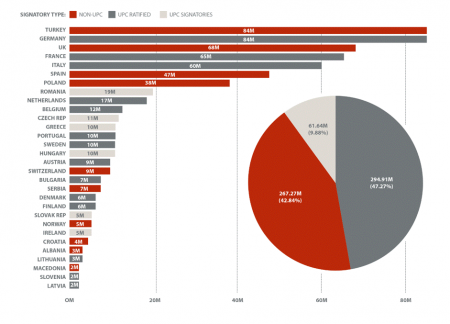Validation costs and renewal fees
Validation Costs
The Unitary Patent (UP) is intended to reduce the cost of obtaining patent protection in the EU. Because of the national validation requirements to file a full translation and the fairly high level of renewal fees, significant savings (at least 40%, depending on the length of the specification) are available using the UP for extensive validation programs. For the most restricted validation programs the UP route will be more expensive than continuing to validate nationally (two to three times more expensive than validating in Germany, France and the UK, for example).
The UPC has 17 participating countries (those that have ratified). A further 7 countries have signed the UPC Agreement, but not yet ratified. Of the 6 largest countries by population in which a European Patent can be made effective, only Germany, France and Italy are participating.
Population by country and signatory type

Renewal Fees
Renewal fees for Unitary Patents will be payable to the EPO on an annual basis. The renewal fee will be due at the end of the calendar month containing the anniversary of the filing date. It may be paid up to six months late with a surcharge. If the renewal fee is not paid in that period, then re-establishment will be possible but this will require a demonstration that the deadline was missed in spite of all due care having been taken.
The official renewal fees will be based on the “True Top 4” i.e. matching the level of official renewal fees of the 4 participating countries (at the time the level of fees were agreed) in which the most patents are validated, i.e. the UK, France, Germany and Netherlands. The level of official renewal fees means that for patents where, under the existing arrangements, four or more of the participating countries would be of interest for validation at grant, then unitary protection is at least an option to consider. However, once unitary protection has been selected, the patentee is committed to this level of renewal fees. The level of renewal fee expenditure cannot be reduced later in the life of the patent by reducing the number of countries, as it can be for national validations of a European Patent. Thus perhaps for cases where the number of countries of interest is only just over this threshold, then unitary protection may not be the best option.
Assuming that renewal fees are paid until expiry, for a full validation program including all states available via a European Patent, using the Unitary Patent will save about 35% on official renewal fees. The saving compared to national validation reduces as the European Patent is made effective in fewer countries. Total official renewal fees payable throughout the lifetime of a European Patent increase by 30% if a UP is chosen, compared to validating in 6 commonly selected countries and increase by 60% when validating only in Germany, France and the UK. Thus for modest validation programs, the national validation route looks attractive from a cost point of view and has increased flexibility in terms of having the option of litigating in the UPC or in national courts and being able to trim the countries in which renewal fees are paid over time.
Of course a range of other factors will need to be considered when deciding whether or not to select unitary protection for any particular case.
Lifetime Cost of Validation and Renewal Fees for Different Validation Programs
A Unitary Patent provides cost savings compared to national validations in a situation where extensive country coverage is required:
All States (Unitary Patent = 37% saving compared to old system)

CH DE DK ES FR GB IE IT NL SE TR (Unitary Patent = 23% saving compared to old system)

National validations provide a cost saving compared to a Unitary Patent where only core country protection is required:
CH DE ES FR GB IT (national validations = 10% less expensive than new system)

DE FR GB (national validations = 40% less expensive than new system)
